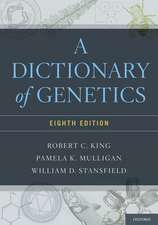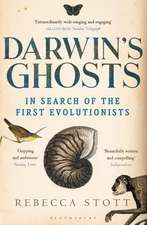Sequence — Evolution — Function: Computational Approaches in Comparative Genomics
Autor Eugene V. Koonin, Michael Galperinen Limba Engleză Paperback – 30 noi 2010
Sequence - Evolution - Function should help bridge the "digital divide" between biologists and computer scientists, allowing biologists to better grasp the peculiarities of the emerging field of Genome Biology and to learn how to benefit from the enormous amount of sequence data available in the public databases. The book is non-technical with respect to the computer methods for genome analysis and discusses these methods from the user's viewpoint, without addressing mathematical and algorithmic details. Prior practical familiarity with the basic methods for sequence analysis is a major advantage, but a reader without such experience will be able to use the book as an introduction to these methods. This book is perfect for introductory level courses in computational methods for comparative and functional genomics.
| Toate formatele și edițiile | Preț | Express |
|---|---|---|
| Paperback (1) | 703.23 lei 38-44 zile | |
| Springer Us – 30 noi 2010 | 703.23 lei 38-44 zile | |
| Hardback (1) | 908.04 lei 43-57 zile | |
| Springer Us – 29 noi 2002 | 908.04 lei 43-57 zile |
Preț: 703.23 lei
Preț vechi: 925.30 lei
-24% Nou
Puncte Express: 1055
Preț estimativ în valută:
134.58€ • 139.98$ • 111.10£
134.58€ • 139.98$ • 111.10£
Carte tipărită la comandă
Livrare economică 09-15 aprilie
Preluare comenzi: 021 569.72.76
Specificații
ISBN-13: 9781441953216
ISBN-10: 1441953213
Pagini: 488
Ilustrații: XIV, 462 p.
Dimensiuni: 155 x 235 x 26 mm
Greutate: 0.68 kg
Ediția:2003
Editura: Springer Us
Colecția Springer
Locul publicării:New York, NY, United States
ISBN-10: 1441953213
Pagini: 488
Ilustrații: XIV, 462 p.
Dimensiuni: 155 x 235 x 26 mm
Greutate: 0.68 kg
Ediția:2003
Editura: Springer Us
Colecția Springer
Locul publicării:New York, NY, United States
Public țintă
ResearchDescriere
Sequence - Evolution - Function is an introduction to the computational approaches that play a critical role in the emerging new branch of biology known as functional genomics. The book provides the reader with an understanding of the principles and approaches of functional genomics and of the potential and limitations of computational and experimental approaches to genome analysis.
Key topics covered in this textbook are:
*the completed and ongoing genome sequencing projects,
*databases that store and organize genomic data, with their unique advantages and pitfalls,
*principles and methods of genome analysis and annotation,
*ways to automate the searches and increase search sensitivity while minimizing the error rate,
*the first lessons from the Human Genome Project,
*the contribution of comparative genomics to the understanding of hereditary diseases and cancer,
*fundamental and practical applications of comparative genomics,
*the use of complete genomes for evolutionary analysis,
*the application of comparative genomics for identification of potential drug targets in microbial genomes,
*Problems for Further Study, which are designed to be solved by using methods available through the WWW.
Sequence - Evolution - Function should help bridge the "digital divide" between biologists and computer scientists, allowing biologists to better grasp the peculiarities of the emerging field of Genome Biology and to learn how to benefit from the enormous amount of sequence data available in the public databases. The book is non-technical with respect to the computer methods for genome analysis and discusses these methods from the user's viewpoint, without addressing mathematical and algorithmic details. Prior practical familiarity with the basic methods for sequence analysis is a major advantage, but a reader without such experience will be able to use the book as an introduction to these methods. This book is perfect for introductory level courses in computational methods for comparative and functional genomics.
Key topics covered in this textbook are:
*the completed and ongoing genome sequencing projects,
*databases that store and organize genomic data, with their unique advantages and pitfalls,
*principles and methods of genome analysis and annotation,
*ways to automate the searches and increase search sensitivity while minimizing the error rate,
*the first lessons from the Human Genome Project,
*the contribution of comparative genomics to the understanding of hereditary diseases and cancer,
*fundamental and practical applications of comparative genomics,
*the use of complete genomes for evolutionary analysis,
*the application of comparative genomics for identification of potential drug targets in microbial genomes,
*Problems for Further Study, which are designed to be solved by using methods available through the WWW.
Sequence - Evolution - Function should help bridge the "digital divide" between biologists and computer scientists, allowing biologists to better grasp the peculiarities of the emerging field of Genome Biology and to learn how to benefit from the enormous amount of sequence data available in the public databases. The book is non-technical with respect to the computer methods for genome analysis and discusses these methods from the user's viewpoint, without addressing mathematical and algorithmic details. Prior practical familiarity with the basic methods for sequence analysis is a major advantage, but a reader without such experience will be able to use the book as an introduction to these methods. This book is perfect for introductory level courses in computational methods for comparative and functional genomics.
Cuprins
Preface. Introduction: Personal Interludes. 1. Genomes from Phage to Human. 2. The Evolutionary Concept in Genetics and Genomics. 3. Information Sources for Genomics. 4. Principles and Methods of Sequence Analysis. 5. Genome Annotation and Analysis. 6. Comparative Genomic and New Evolutionary Biology. 7. Evolution of Central Metabolic Pathways: The Playground of Non-orthologous Gene Displacement. 8. Genomes and the Protein Universe. 9. Epilogue: Peering Through the Crystal Ball. Appendices. References. Index.
Caracteristici
Completed and ongoing genome sequencing projects
Databases that store and organize genomic data, with their unique advantages and pitfalls
Principles and methods of genome analysis and annotation
Ways to automate the searches and increase search sensitivity while minimizing the error rate
The first lessons from the Human Genome Project
The contribution of comparative genomics to the understanding of hereditary diseases and cancer
Fundamental and practical applications of comparative genomics
Use of complete genomes for evolutionary analysis
Application of comparative genomics for identification of potential drug targets in microbial genomes
Problems for Further Study, which are designed to be solved by using methods available through the WWW
Databases that store and organize genomic data, with their unique advantages and pitfalls
Principles and methods of genome analysis and annotation
Ways to automate the searches and increase search sensitivity while minimizing the error rate
The first lessons from the Human Genome Project
The contribution of comparative genomics to the understanding of hereditary diseases and cancer
Fundamental and practical applications of comparative genomics
Use of complete genomes for evolutionary analysis
Application of comparative genomics for identification of potential drug targets in microbial genomes
Problems for Further Study, which are designed to be solved by using methods available through the WWW













